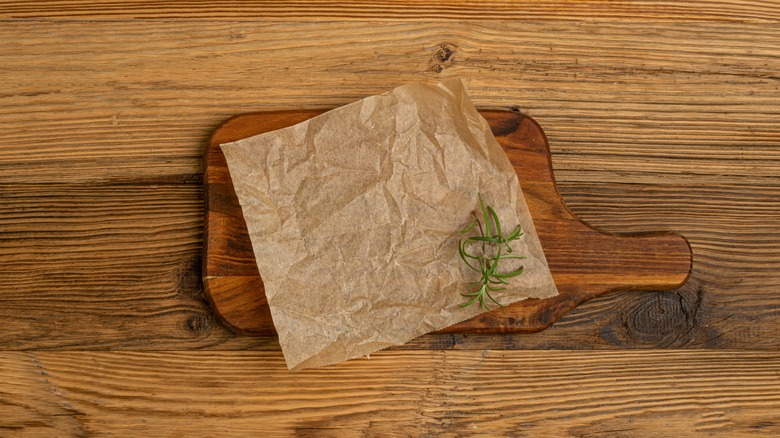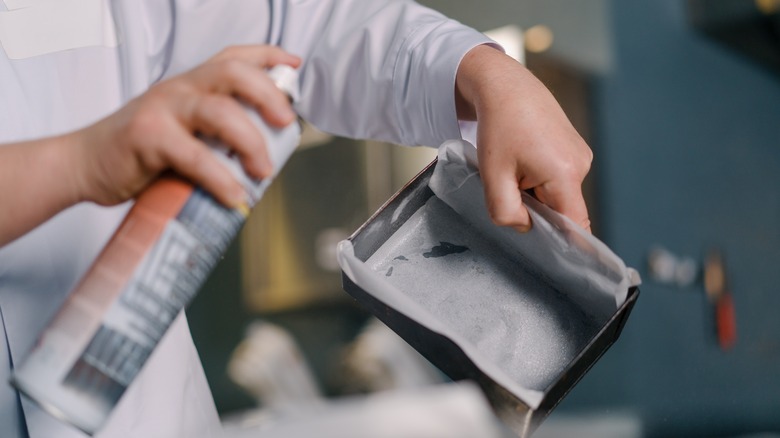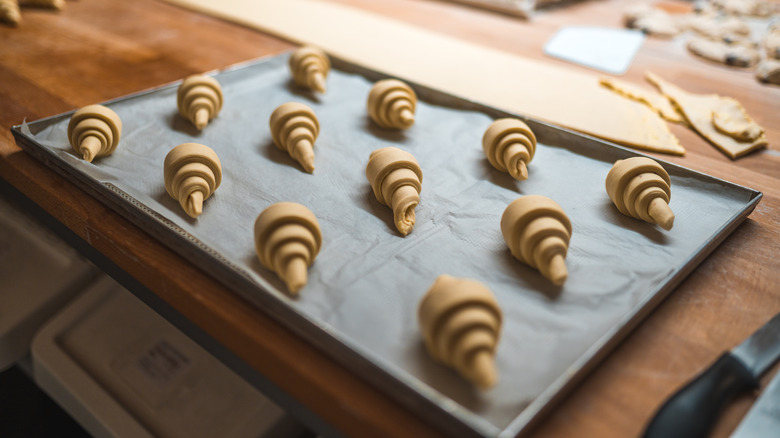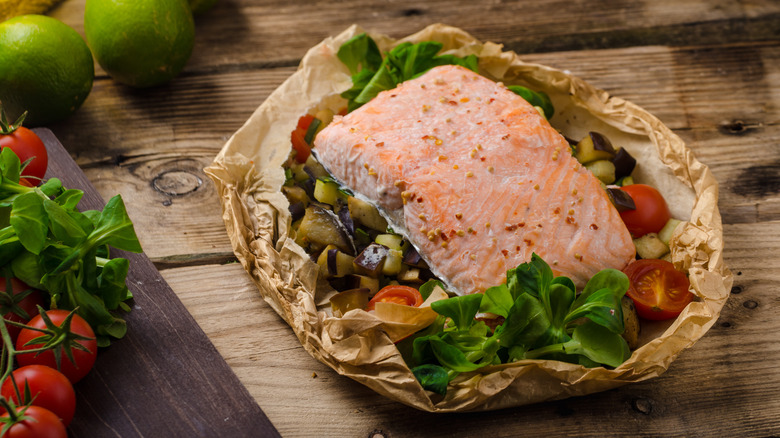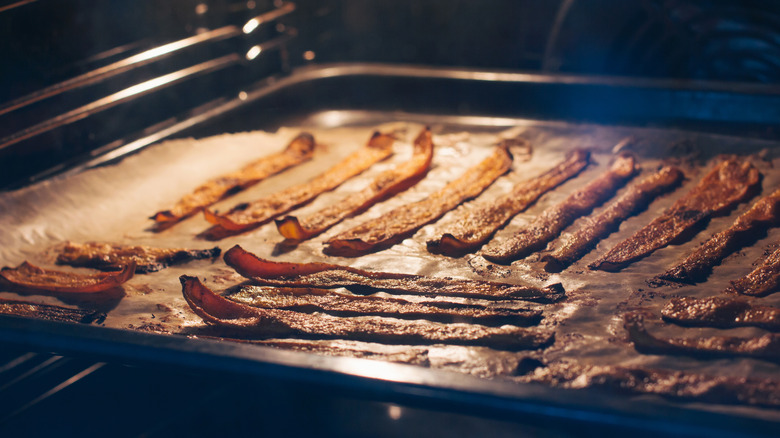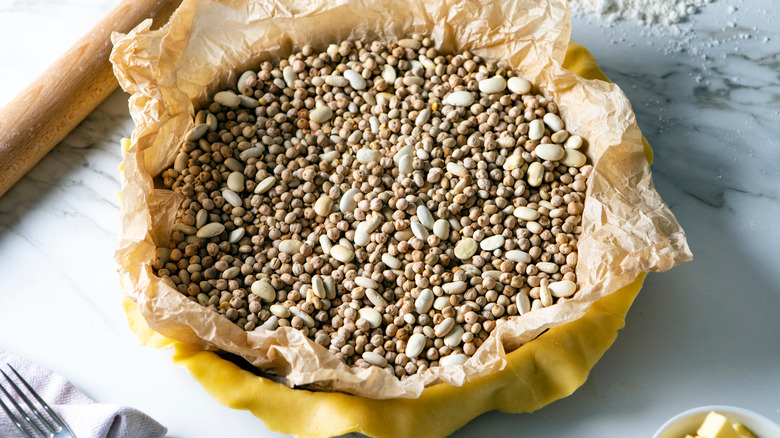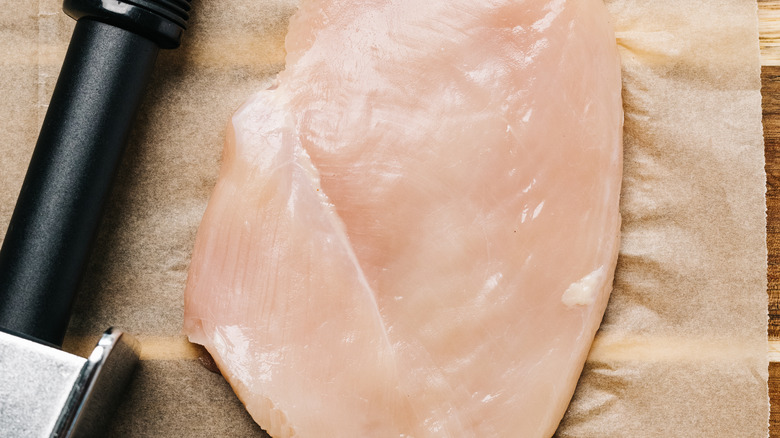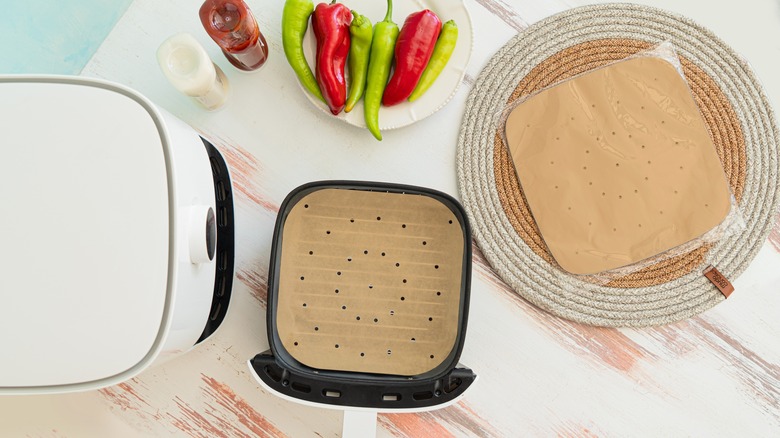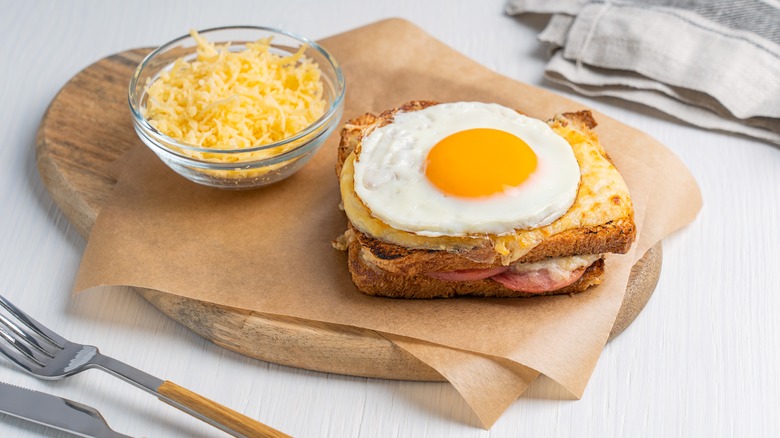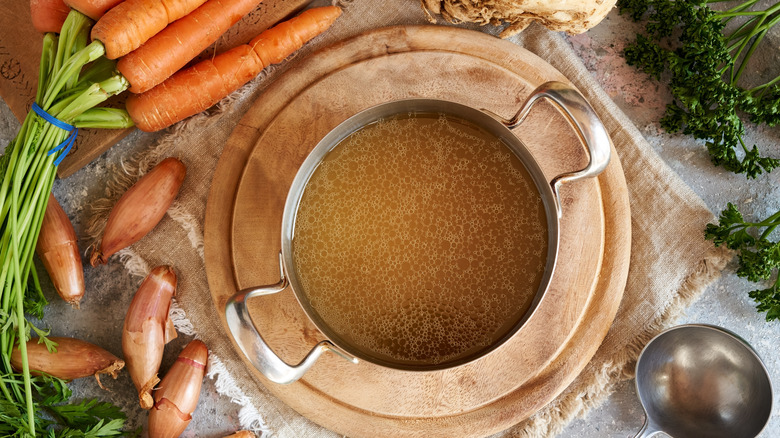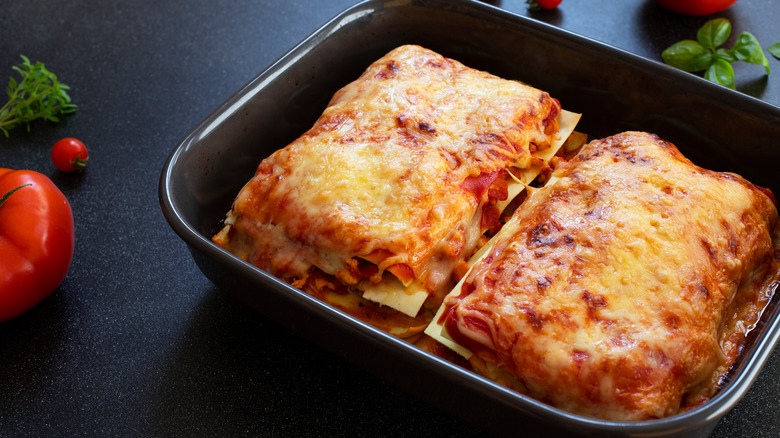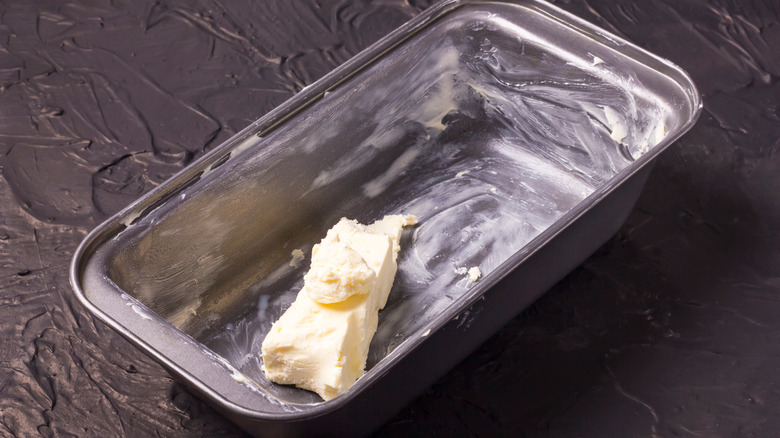12 Parchment Paper Cooking Hacks You'll Use Forever
Most of us will have a roll of parchment paper tucked in the kitchen cupboard beside the aluminum foil and plastic wrap that we bust out on occasion to line a pan. But that isn't the only use for the stuff. Parchment paper is actually a highly versatile kitchen tool that can be useful for many cooking, baking, and storage techniques.
First, make sure it is, in fact, parchment paper you've got on hand. Wax paper looks very similar, but it is not always interchangeable. The difference between parchment and wax paper is, of course, wax. Wax paper has been lined with paraffin or soy wax and doesn't do well with heat. It should not go into the oven, onto the stove, or into the air fryer where the wax can melt into your food and the paper can catch fire. Parchment paper, on the other hand, is treated to resist moisture, grease, and heat. It can withstand temperatures over 400 degrees Fahrenheit. It usually costs a bit more but it's more versatile, so it's worth investing in a roll. And if you have to pick one, pick parchment.
You can find parchment paper sold in rolls or pre-cut segments. It's also available in white and brown varieties. The white paper has been bleached; the brown paper is a little more natural and has a nice rustic look that can sometimes lend itself better to presentation, for instance at a bake sale.
Line your cake and cupcake tins
The most classic application you may already be familiar with is lining cake tins and baking dishes. When placed on the bottom of a tin, baking dish, or springform pan, parchment paper will stop a cake from sticking and facilitate much easier removal from the mold. You can even line cupcake tins with smaller pieces of parchment paper.
It can be frustrating to get a piece to fit properly. Most rolls of parchment paper are much wider than the average dish and require a little trimming down to the right size. It's easy to cut it wrong and end up playing Tetris with a few random strips. Fortunately, there are some nifty cutting and folding tips for lining any pan with parchment paper.
Another trick that comes in handy when baking certain tea cakes and loaves is to leave a little overhang. Cut a piece of parchment paper that is longer than the pan and let it hang over two sides by an inch or two. Then, after partially cooling, your cake will lift right out of the pan by the parchment paper "handles" on either side. But don't leave too much outside the pan, or you run the risk of making a potentially dangerous oven mistake. Parchment paper can take a lot of heat, but if it's left pressed up directly against the heating elements of your oven, it can still burn or catch fire.
Bake like a professional
If you've got the desire to add a little extra decoration to your cake, but you don't have a piping bag on hand — because you're not a patissier working in a professional bakery — bust out the parchment paper and you can rig up a pretty good replacement. "Piping" is a technique of applying frosting or icing decorations by squeezing the icing through a small hole or molded bag tip. Since parchment paper is pretty moisture-resistant and non-stick, you can roll up a square, leaving a little opening at the bottom, and use it as a makeshift piping bag. Fill up the parchment paper cone with frosting and get to decorating!
Another baking task that can be a little tricky for the at-home chef is churning out multiple batches. You only have one small oven, after all, and maybe two or three baking sheets. But lining the sheets with parchment paper can really help you pick up the pace and lower the turnaround time when batch baking. Cookies won't stick to the parchment, and you can easily slide them off and start your next batch. Or, slide the whole sheet of parchment off to another surface to cool and throw a new one on the baking sheet. No more waiting forever for baked goods to cool or washing burnt scraps off your trays between batches.
Cook dinner en papillote
When you want to cut the cleanup altogether, cooking in a parchment paper packet is the way to go. This method, called "en papillote," is a common French technique and an excellent way to cook a healthy meal. Place fresh ingredients on a sheet of parchment paper, along with fresh herbs, sliced lemons, and other seasoning. Then fold the paper up or tie it with twine. This traps steam inside the packet while it's baking which helps cook the food with less oil. It's a hybrid roasting and steaming method that's most commonly used to prepare fish.
Flaky white fish, salmon, or even poultry steam inside a parchment paper cocoon in the oven. Using parchment paper keeps the delicate flesh from sticking to a baking dish. It's also possible to cook veggies this way. Asparagus, squash, or carrots en papillote are the perfect side dish with your fish. You can even wrap them up together if they require a similar time to cook.
This is not a cooking method that yields a crispy salmon skin or a charred broccolini, but it is a great way to achieve soft tender food, steam in some herbal and citrus flavors, and minimize oil and fat. Plus, it makes cleanup super easy when there's nothing to scrub. Just toss the parchment paper when you're done. Preparing your next meal en papillote may sound fancy, but while it is sophisticated, it's not that hard!
Minimize mess
One of the major benefits of cooking with parchment paper is reducing cleanup in the kitchen. Parchment paper is designed to repel grease and moisture, so you can sometimes reuse it. But even if the paper is a mess, it's probably stopped the mess from tarnishing your cooking implements and appliances. Tough baked-on stains and grease can be difficult to clean off baking dishes and cookie sheets, but when you line them with parchment paper, that won't be a problem.
Roasting vegetables on a sheet of parchment paper can be a great way to stop the veg from sticking to the pan. This won't always be the best option for every vegetable, because it can prevent deep caramelizing and browning, but parchment paper can be helpful if you want to minimize the cleanup process and avoid baked-on oils that are hard to clean off your baking sheets.
Another infamous purveyor of grease is bacon. Cooking bacon in the oven is an easy way to cook several strips at once, evenly, and without splattering your stovetop or your arms in hot grease. But bacon does render out a lot of fat. Lining a baking sheet with parchment paper is a great way to expedite cleanup. Once you remove the cooked bacon, let the fat solidify again, then toss out the parchment paper. The baking sheet underneath will be much easier to wash off.
Roll out your dough and blind bake
If you've ever found yourself peeling sticky bits of dough off a rolling pin for the 10th time before re-rolling again, you will definitely want to try this hack. Overworking dough can actually ruin the texture, taking your pie crust from flaky to tough in minutes. Eliminate this unfortunate outcome by rolling it right the first time. Rolling cookie or pie dough between sheets of parchment paper keeps the dough from sticking to your rolling pin and minimizes the amount of added flour you need to dust it with. If you're making a galette, you can keep it on parchment paper and slide the whole thing onto a cookie sheet.
Once your perfect crust is nestled into its tin, you can also use the parchment paper for blind baking. Blind baking is a process of partially baking crust before filling. It's sometimes called for to ensure your crust won't be soggy or underbaked. Usually, you'll want to weigh the crust down during a blind bake. Do this by simply placing a sheet of parchment paper on top of the crust, and then filling it with dried beans, baking marbles, or a pie weight. The weight will keep the crust from puffing up, and the parchment paper will keep the weights from touching the dough directly. Parchment paper can handle the heat of the oven and it won't stick to your crust so it's easy to lift off.
Tenderize meat
Parchment paper is similarly useful when pounding out beef, chicken breast, or pork. Some recipes like chicken piccata, schnitzel, and fried steak call for thinly pounded or tenderized meat. Particularly if you're going to pan-fry it, you may want to pound it first. There are several reasons why you might want to tenderize your chicken before cooking it, but If you don't want pieces to break off and stick onto your kitchen tools or cutting boards, or you're worried about spreading bacteria around, parchment paper is here to take the hit.
Place a piece of meat between two sheets of parchment paper on a cutting board. Then use a meat tenderizer or mallet to pound it until it reaches the desired thickness. Be sure to cut a piece of parchment paper large enough to cover the area of the final pounded shape, or else you'll still end up with raw meat spilling over the edges onto the cutting board.
Store ingredients in the fridge or freezer
When it comes to storing leftovers, plastic wrap and foil will often do the trick, but many food items, like cheese, can stick to those and become a gooey mess when you try to unwrap them later. Parchment paper is designed to be non-stick and often works better for storing certain foods. You can place strips of parchment paper between layers of baked goods when storing them in containers. This way they won't smush into one another.
This is a neat parchment paper trick to store raw bacon. Another fun kitchen hack is to freeze individual serving-size pats of tomato paste in between little pieces of parchment paper. If you've ever bought a tin of tomato paste only to find that most of it went moldy in the back of your fridge, you might be interested in this clever hack to save waste. No recipe seems to call for more than 1 or 2 tablespoons at a time, but the leftover tomato paste can be spooned out between sheets of parchment paper. Then simply pop them all in a zip lock bag and throw them in the freezer. Next time you need some, you'll already have it perfectly portioned.
Coat your air fryer
Not lining the basket is one of the many mistakes you can make when using an air fryer. While air frying uses less oil than other cooking methods, the oil that is still there can often end up caked onto the fryer basket and become very difficult to scrub off. This appliance is supposed to make cooking easier, not more difficult, right? To minimize cleanup, try lining your air fryer with parchment paper.
Lining with parchment paper is one of the easiest and most useful air fryer hacks. Not only will it make it less messy and streamline your cleaning process, but it will also stop things from sticking to the fryer. Meat, potatoes, and even veggies can sometimes get stuck on the tray or basket, but a little layer of parchment paper will put an end to all that. Just be sure to poke some holes in the paper to keep the hot air circulating and ensure an even cook.
Fry an egg
We don't typically think of using parchment paper on the stovetop, but think again. While you never want to place any kind of paper directly on your element or an open flame, safely tucked inside a frying pan, parchment paper can occasionally be a helpful way to stop foods from sticking.
Unfortunately, many non-stick pans lose their eponymous non-stick properties over time. If you've noticed that you're sacrificing half your eggs to the bottom of the pan, no matter how much heat, oil, or butter you use, try this mess-free trick for frying eggs. Line the pan with parchment paper and turn on the heat. Then place a little butter on top of the paper and crack an egg in as usual. You won't want to flip it; instead, pop a lid over the pan and let the egg cook until your desired yolk consistency has been achieved. Then you can slide the paper and the egg off leaving nothing stuck on the pan!
Remove excess grease
Parchment paper is not only a great tool for lining, wrapping, and storing things. It can also be used to skim the fat off the top of your next batch of stock. If you're into all things homemade, and minimizing food waste, chances are you've tried your hand at making a homemade stock. The process can take some time but the results are undeniably worth the effort.
Tastier and often healthier than their store-bought equivalent, homemade bone broths and stocks are a fabulous way to use up kitchen scraps. But you may have noticed that a homemade stock contains quite a lot of fat. Sometimes you may want to leave it in, but parchment paper can help remove excess fat when you want to. Once your stock has started to cool, take a little square of parchment paper and pass it over the top of the stock. The fat, which rises to the top, will stick to the paper which you can then toss.
Prepare lasagna or tamales
Some delicious and crowd-pleasing dishes can feel a little intimidating to tackle in your own kitchen. When a recipe has many steps and elements to prepare, it can be helpful to do some in advance. If making a lasagna sounds like a lot of work, try this parchment paper hack to help you prep the noodles ahead of time. Noodles can be frustrating when they start to stick together. Placing small sheets of parchment paper between the boiled lasagna noodles will stop that from happening.
Another dish that takes a good amount of TLC to get across the finish line is tamales. These Central or South American steamed and individually wrapped masa pockets are perfect party food, but it takes some time to prepare a large batch. They also traditionally require corn husks or banana leaves to wrap the dough and filling. Depending on where you live, and how much time you have to hunt down your ingredients, those might be hard to find. So when corn husks or banana leaves aren't readily available at a grocery store near you, sub in some parchment paper to wrap your tamales and get the job done.
Make it stick
Once you've figured out how to cut the right size piece of parchment paper for the task at hand, and avoided this parchment paper tearing mistake, you still might find it won't stick in place. If you've struggled when lining a baking dish to keep the parchment paper from curling up, try greasing the pan a little first. If you're lining a cake tin, you can butter the sides and bottom lightly before pressing in the paper. Now that the paper is sticking to the pan, it won't leave indents on the bottom of your cake. Just don't forget to peel it off before serving, or your guests might get a mouthful of paper mixed in with their dessert.
In other cases when you don't want added grease, Alton Brown makes parchment paper stick to baking dishes by simply spritzing a little bit of water on the dish first. This is perfect when your goal is to minimize cleanup and baked-on oil. Just fill a spray bottle with some water and give a quick spritz before lining. It's that simple!
